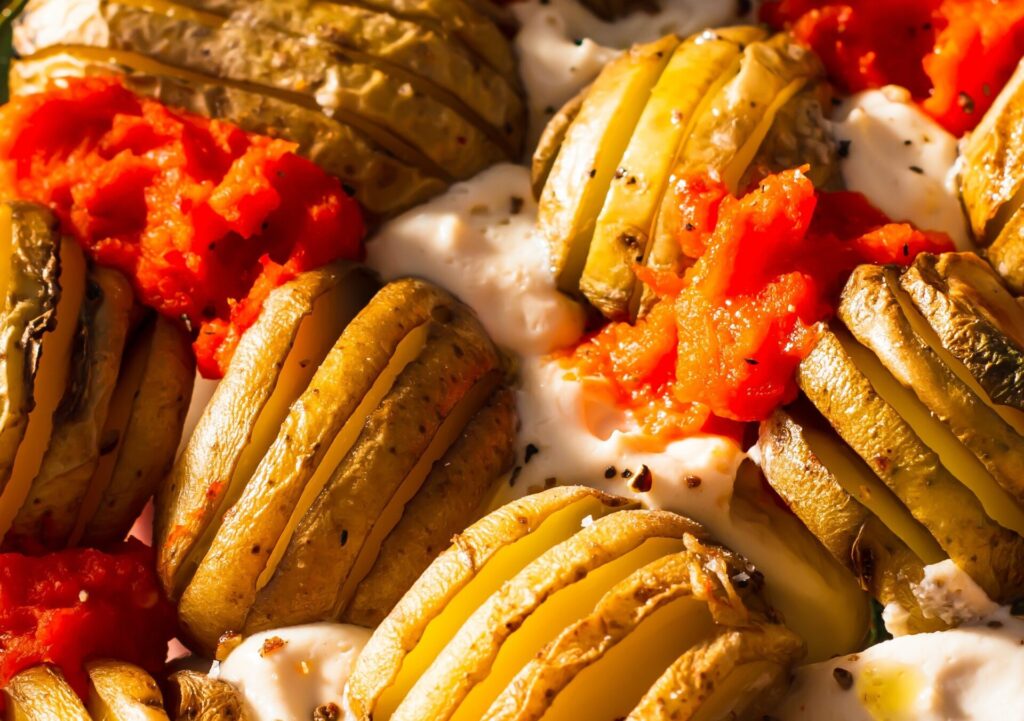The Journey of Potato From Providence to Plate
Potatoes, what a phenomenal vegetable it is. It can be used in myriad manners. One of the principal food crops grown worldwide is the potato, which is indigenous to the Peruvian-Bolivian Andes. As a cooked vegetable, potatoes are commonly served whole or mashed. They are also processed into potato flour, which is used in baking and as a sauce thickening.
Some extraordinary finger-licking dishes where potatoes are the main characters are mashed potatoes, french fries (my personal favorite), hash browns, baked potatoes, croquettes, and the list is never-ending. Just talking about this makes me hungry. However, we are not here to talk about the popular kinds of vegetables. We are here to discuss the demand and supply of potatoes.
Potatoes are one such produce that is found in every household, restaurant, cafe, etc. Potatoes are found in places one cannot even fathom. However, it strikes a question in our minds. How did the craze for potatoes start?
It is believed that potatoes were domesticated separately multiple times before being substantially grown in South America by the Incas 1,800 years ago. During the second part of the 16th century, potatoes were discovered by the advancing Spaniards and brought into Europe. The plant became a significant crop in Ireland by the end of the 17th century, and in continental Europe—particularly in Germany and the west of England—by the end of the 18th. Throughout the first forty years of the 19th century, it continued to expand, both in the Western and Eastern hemispheres and the Irish economy itself grew dependent on the potato.
Spud Vending
The geographical segments of the potato market include North America, Europe, Asia-Pacific, South America, and Africa. The potato market is anticipated to increase at a CAGR of 3.50% from 2023 to 2028, from a size of USD 111.83 billion in 2023 to USD 132.81 billion in 2028.
After rice and wheat, potatoes are the third-most significant food crop in the world in terms of human consumption. Potatoes are available in more than 4,000 different edible varieties, most of which are grown in South America’s Andes. There are more than 180 different varieties of wild potatoes, however due to their bitter flavor, they are not edible. Potatoes are naturally resistant to insects, illnesses, and environmental factors. In emerging nations, the increase of potato-producing regions has quickly surpassed that of all other food crops. For millions of people in South America, Africa, and Asia, particularly Central Asia, it is a crucial component of food security. Globally, more than a billion people consume potatoes.
Potatoes offer several benefits over other food crops, including simple storage, a high yield, a low planting demand, a large planting area, and a high nutritional content. Due to these characteristics, potatoes are a good crop for the processed food sector.
Potatoes in The European Market

In Northern Europe, potatoes are perhaps the most common staple meal. Without potatoes, it is difficult to imagine European cuisine. One of the greatest per capita potato consumption rates may be found in Europe. In Europe, Belarus (182 kg) and Ukraine (139 kg) consume the most potatoes.
The two primary segments of the worldwide potato market are fresh and chilled potatoes. While chilled potatoes are shipped or imported and utilized in the food processing business, fresh potatoes are used for daily eating.
Owing to their lengthy shelf life, potatoes have gained popularity even in nations that have not historically consumed them. In the processed food sector, where processed goods make up the majority of potato consumption, fresh potatoes are in extremely high demand globally.
The top countries exporting fresh potatoes globally in 2020, according to the International Trade Map, were France, Germany, China, the Netherlands, Canada, and the United States. In 2020, the major potato-producing nations worldwide were China, India, Russia, the United States, and Germany, with yields of 78.2 million metric tons, 51.3 million metric tons, 19.6 million metric tons, 18.8 million metric tons, and 11.7 million metric tons, respectively.
Therefore, the rising worldwide output and rising global demand for potatoes indicate a favorable trend for the potato market throughout the projection period. In short, everyone loves potatoes, they want them, they need them and they cannot survive without them.
In addition to being a vegetable for home cooking, potatoes have many other uses. Less than half of the potatoes that are cultivated worldwide are eaten fresh. The remaining substance gets transformed into starch for the industry as well as other edible goods and components made from potatoes that are given to hens, pigs, and cattle. Fresh potatoes are becoming less popular as processed, added-value foods take their place.
Frozen potatoes, which make up the majority of the french fries offered in restaurants and fast-food chains throughout the world, are one of the key commodities in that category. Another manufactured delicacy that rules the snack food industry in many industrialized nations is the potato crisp. Dehydrated potato flakes are used as a culinary additive, a component in snacks, and even in retail mashed potato goods.
The food sector uses potato flour, another dried product, to bind meat mixes and thicken gravies and soups. Potato starch, a fine, flavorless powder with “excellent mouth-feel,” has a higher viscosity than wheat and maize starches and produces a tastier product. It serves as a binding ingredient in cake mix, dough, biscuits, ice cream, and sauces and stews. Crushed potatoes are heated throughout Eastern Europe and Scandinavia to transform their starch into fermentable sugars used in the distillation of alcoholic drinks like vodka and akvavit.
Potatoes truly are crushing it. They have such a cult hold on the produce market that literally no retailers, owners, and/or traders want to miss out on having their share of profits from this vegetable.
Potatoes in The American Market

In the United States, the amount of potatoes processed reached 14 million metric tons, a little rise from 2020. 3 million metric tons of potatoes—a 2% increase from the previous year—were used to make chips and shoestrings. In 2020, 8.6 million metric tons of raw potatoes were used to make frozen french fries and other products, a 2% rise from 2018. With sales of more than USD 4.8 billion in 2020, Frito-Lay was the largest supplier of potato chips in the US. Lay’s, Cheetos, and Doritos chips are a few of the brands owned by Frito-Lay.
After two years of decline, the Latin American sweet potato market began to recover in 2019 and reached $3.4 billion for the first time since 2016. From 2013 to 2019, the market value climbed at an average yearly rate of +3.2%. The trend pattern was largely consistent, with some observable swings noted in select years. The market reached its peak during the time under evaluation in 2019, and subsequent expansion is expected to continue.
Potatoes in The Asian Market

Right now, China is the world’s greatest producer of potatoes. According to FAOSTAT statistics, the nation’s potato output was estimated to reach 75,657,850 metric tons in 2019 and 78,236,596 metric tons in 2020. 4,038,885 hectares were harvested in 2019, and this number climbed to 4,218,188 hectares in 2020. The cultivation and consumption of potatoes have risen significantly in China for a variety of reasons. Potatoes may be grown all year round due to their year-round adaptability, short growth cycle, and suitability for a variety of topographies and climates across the nation.
The majority of China’s fresh potatoes are used for table consumption. According to industry sources, 60% of Chinese potatoes are eaten fresh in restaurants and homes. With the rising urbanization, there is a growing middle-class population. This demographic is more drawn to Westernized food, which has led to the popularity of processed potato goods.
Following China, India is the world’s top producer of potatoes. India’s potato production has climbed steadily since 2020. The rise in consumption of potatoes in the nation is closely correlated with the rise in production. In India, the demand for ready-to-eat convenience meals has increased as a result of urbanization and industrialization. This has increased demand for potato-based frozen processed foods.
Potatoes in The Australian Market

When James Cook claimed eastern Australia for Britain in 1770, potatoes were on board his ship. Potato planting started 18 years later, with the start of colonization. Today, “spuds” are farmed all over the continent, from tropical North Queensland to the temperate southern state of Tasmania.
Between 1960 and 1990, Australian potato production more than quadrupled, rising from 450,000 to 1.2 million tonnes. Even so, since 1990, output has stabilized at an annual average of roughly 1.3 million tonnes. With more than 40% of the nation’s total vegetable production coming from potato tubers, they are the most significant horticultural crop in the nation. More than 60% of it is made into frozen potato goods and crisps, while only around 37% is sold fresh.
The market for fresh potatoes has recently been impacted by competition from foods like pasta and rice, and according to estimates from the FAO, between 1995 and 2005, the annual per capita consumption of potatoes reduced from 55 kg to 53 kg.
In 2021, the Australian potato market increased by 1.7% to $X for the first time since 2018, thus ending a two-year declining trend. Consumption, however, still shows a noticeable reduction overall. With a rise of 7.8% over the previous year, 2017 had the fastest growth speed. The market reached record highs of $X throughout the period under study in 2012. Nevertheless, from 2013 to 2021, consumption remained at a little lower level.
Ending of The Potato Saga
As we peel back the layers of the potato market, it becomes evident that this unassuming tuber plays a pivotal role in the global food industry. I’d be playing out like a broken record if I mentioned everyone’s love for potatoes. Farmers, distributors, and consumers find it easy to enter this market and create a consumer base for it. Nonetheless, with this gigantic amount of farming and production at a rate where the demand exceeds the supply, it is cardinal to embrace sustainable practices and stay attuned to market trends. Through ingraining environmentally conscious practices, we can ensure that the potato continues to hold its esteemed place on our tables for generations to come. Now let’s kick back and enjoy a plate of fries.








